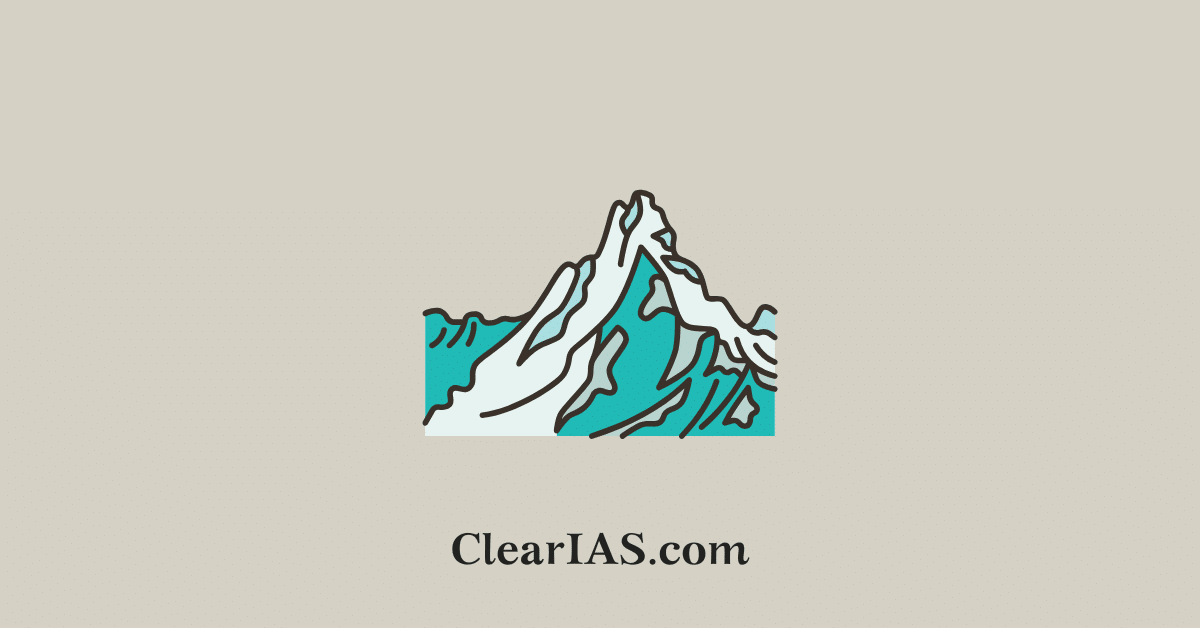
Is the Gangotri glacier losing snow earlier than usual? Recent studies have stipulated this observation, which can have a profound impact on the water cycle in the region. Read here to learn more.
A recent study published in the Journal of the Indian Society of Remote Sensing has reconstructed four decades (1980–2020) of hydrological flow, revealing how climate change is reshaping the cryosphere, altering seasonal river discharge, and threatening long-term water security.
Traditionally, the snowmelt in the Gangotri Glacier followed a seasonal rhythm, with peak meltwater contributing to river discharge during the summer months (June-September).
However, evidence now shows that earlier snowmelt and irregular rainfall patterns are altering this natural cycle.
Composition of the Gangotri Glacier System
- The GGS spans 549 km², with nearly 48% glacierised area.
- It comprises four glaciers:
- Gangotri Glacier: 140 km² (largest)
- Chaturangi Glacier: 75 km²
- Raktavaran Glacier: 30 km²
- Meru Glacier: 7 km²
- Elevation range: 3,767 m to 7,072 m.
- Climatic inputs:
- Western Disturbances (Oct–Apr) – Snowfall recharge.
- Indian Summer Monsoon (May–Sept) – Rainfall-driven runoff.
- Average seasonal rainfall: 260 mm (May–Oct).
- Mean annual temperature: 9.4°C (2000–2003).
This unique mix of snow, ice, and monsoonal rainfall makes the GGS an ideal case study to assess climate-driven hydrological changes in the Himalayas.
How Climate Change is Altering the Water Cycle in the Gangotri Glacier System
Recent studies on the Gangotri Glacier System (GGS), the source of the Bhagirathi River in the central Himalayas, suggest that the glacier is indeed losing snow cover earlier in the year than before, primarily due to climate change-driven warming and altered precipitation cycles.
- Earlier Snowmelt and Glacier Retreat
- Rising spring and early summer temperatures are causing snow to melt sooner than usual.
- This has led to a shift in peak discharge timing, water is released into the Bhagirathi earlier in the year.
- As glaciers retreat, the contribution of glacial melt to river flow initially increases (due to accelerated melting), but will decline in the long run once glaciers shrink beyond a threshold.
- Changing Precipitation Patterns
- Traditionally, the glacier system received snow during winter, which sustained summer flows.
- Now, a greater fraction of precipitation falls as rain instead of snow, reducing long-term snowpack accumulation.
- This alters the seasonal balance of water supply, with more immediate runoff and less storage in the glacier for gradual release.
- Impact on Bhagirathi River Discharge
- Short term (near future): Increased runoff from accelerated glacier melt may lead to higher summer flows and even floods.
- Long term: As the glacier mass depletes, the discharge into the Bhagirathi will decline, threatening water security, agriculture, hydropower, and ecosystems downstream.
- Discharge reconstruction studies show that baseflow (the sustained contribution from glacier melt in dry seasons) is decreasing, meaning rivers may run drier in late summer and autumn.
- Hydrological Extremes
- The GGS is experiencing greater hydrological variability, with alternating extremes of flooding in monsoon months (due to heavy rainfall + glacier melt surges) and water scarcity in post-monsoon periods.
- This impacts not just river ecology but also hydropower projects, irrigation systems, and drinking water supply dependent on the Ganga.
- Broader Climate Change Links
- Rising Himalayan temperatures are nearly double the global average.
- Increase in black carbon deposition (from forest fires, crop burning, industrial pollution) accelerates glacier melt by reducing surface reflectivity (albedo).
- Combined, these forces make Gangotri, one of the largest Himalayan glaciers, particularly vulnerable.
Why This Matters
- The Ganga River basin supports about 40% of India’s population.
- The Bhagirathi River, fed by the Gangotri Glacier, is a lifeline for communities in Uttarakhand and further downstream.
- Altered water cycles pose challenges for water availability, food security, hydropower, and disaster management.
Way Forward
- Continuous Monitoring: Strengthen glacier monitoring networks using satellites, drones, and ground-based stations.
- Adaptation Planning: Design climate-resilient water management strategies, including improved irrigation and storage systems.
- Glacier Conservation: Reduce local drivers like black carbon emissions through stricter emission standards and clean energy.
- Community Preparedness: Train downstream communities in disaster risk reduction, flood preparedness, and water-use efficiency.
Conclusion
The new study underscores that the Gangotri Glacier System is losing snow earlier and shifting discharge peaks forward, transforming the water cycle of the Bhagirathi River.
While immediate impacts include higher summer flows and flood risks, the long-term danger lies in declining snow and ice reserves, which will reduce river discharge and jeopardize water security.
This calls for urgent climate adaptation, glacier monitoring, and sustainable water management policies to safeguard the future of India’s most sacred and vital river system.
Related articles:







Leave a Reply